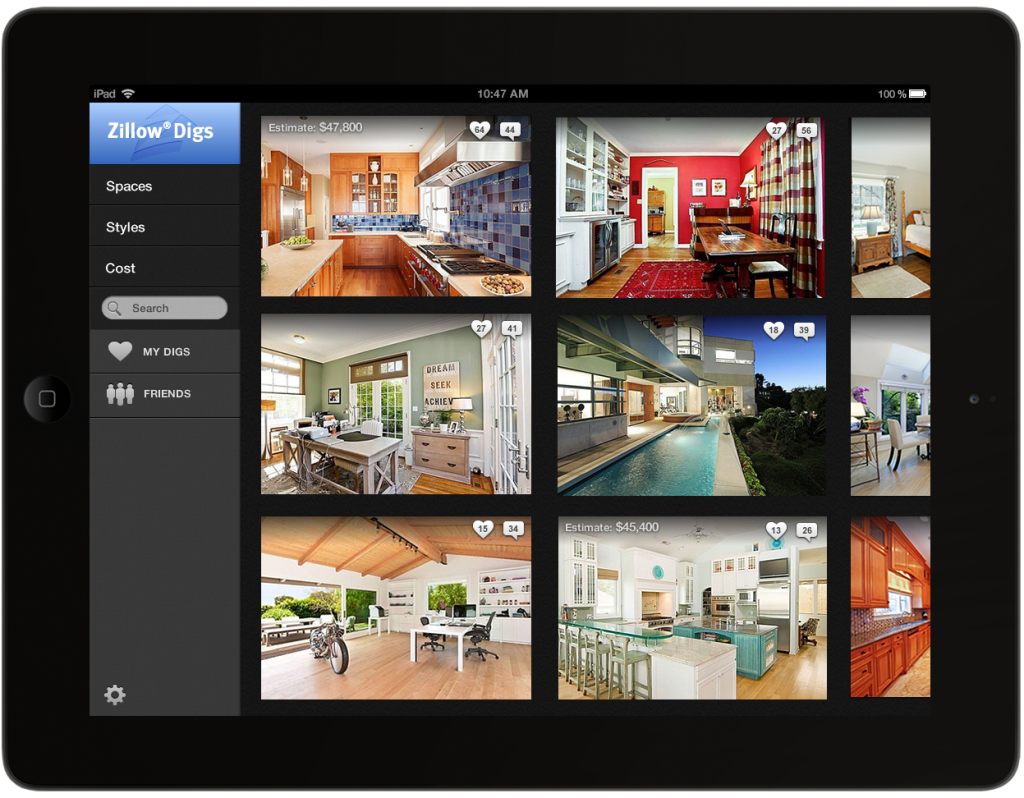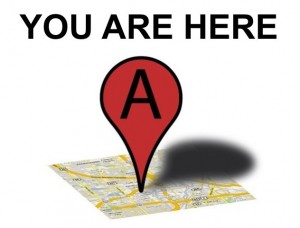 Here are 5 ways to stand out using hyper local keywords and tactics.
1) Get specific, and then get more specific
‘Real Estate for Sale in X’ is a fine keyword, but it is incredibly broad, and with broad, all-encompassing keywords comes competition. When you work in a metropolitan area or in an area with a lot of competition, it pays to get hyper local with your SEO. For instance, let’s say you’re a real estate agent in Chicago, every other real estate agent and brokerage in Chicago is going to be focusing in on ‘Chicago’. Take it a step further and focus on the neighborhoods you serve, ‘homes for sale in Lincoln Park’ for example. If you’ve followed our past blog posts (‘Get Specific and Go Local’ and ‘Content is Key(word)’) we may sound like a broken record, but going hyper local with your keywords will help ensure the right customers are finding your website.
2) Be a recognizable face in your neighborhood
As a real estate agent or brokerage, it is important to show you are an expert in your local community. So get involved! Show that involvement on the neighborhood pages of your agent or brokerage website. Offer a list of the top things to do in your neighborhood. Give information about the shopping, the nightlife, the restaurants, the schools, etc. Creating pages on your site that give details about your marketplace, the surrounding shops and businesses and insights into the homes in the area, allows you to be in expert in ways that nobody from outside your marketplace could possibly do. Plus, when you write about community news and events, you naturally attract people who are fans of that community. Everything you do, both online and off, can be leveraged for SEO.
3) Get social
Along with showing your neighborhood expertise on your neighborhood pages and website, social media is a fantastic way to connect with your community. Social media and local SEO are interdependent. Social networking sites, like Facebook, often have geotag media, creating an optimization point for local SEO. This gives credibility to a business and solidifies its location within search engine listings.
Furthermore, post photos of new listings, photos of happy new home owners, share local events, links to blog posts, neighborhood trivia, and your pets – whatever! Just start posting and sharing. Social signals are becoming increasingly important for SEO so the more times your content is shared on social sites the more valuable it becomes to the search engines.
4) Utilize Google Applications
The data you input in your Google+ profile, the connections you make, the interactions you have and the posts you make are all part of an increasingly visible digital footprint that begins to define ‘you’ as an entity in Google’s search. Google is starting to view this information as humans see it, which means that you are likely to have a more targeted audience in Google search than ever before. And the key here is relevance. This is because in most cases Google can see the general location of a searcher, or the location he or she is searching for. When localization is in play for your area, Google will boost your search result even more for in-network users, and more importantly for mobile search.
For example, the listing of a condo for sale in Chicago posted on Facebook may get a little bit of interaction with some of those who see it, it may get re-shared a few times, a few comments might be posted, but its chances of finding a buyer are slim and the post will get buried in the stream of new content within a couple of hours or so. The chances then of the right person seeing it, at the right time, with the right mindset, are so slim that they hardly do justice to the effort involved in posting it. Posting on Google+ is a whole different, and better, ballgame. The data is indexed by Google. The search engine notes that the listing is for a condo in Chicago. Google will move your listing to the top of the search when it’s relevant to the search query.
Quick tip: It is important to just get your presence felt through these Google+ pages and Google Local. The way to start going about this is creating profiles for all of your offices and be sure to completely fill out those profiles. Incorporating photos, video, address, local phone number, business hours, etc, will help your local search results. Correlation studies show that Google takes “profile completion percentage” into account when ranking Google pages.
Here are 5 ways to stand out using hyper local keywords and tactics.
1) Get specific, and then get more specific
‘Real Estate for Sale in X’ is a fine keyword, but it is incredibly broad, and with broad, all-encompassing keywords comes competition. When you work in a metropolitan area or in an area with a lot of competition, it pays to get hyper local with your SEO. For instance, let’s say you’re a real estate agent in Chicago, every other real estate agent and brokerage in Chicago is going to be focusing in on ‘Chicago’. Take it a step further and focus on the neighborhoods you serve, ‘homes for sale in Lincoln Park’ for example. If you’ve followed our past blog posts (‘Get Specific and Go Local’ and ‘Content is Key(word)’) we may sound like a broken record, but going hyper local with your keywords will help ensure the right customers are finding your website.
2) Be a recognizable face in your neighborhood
As a real estate agent or brokerage, it is important to show you are an expert in your local community. So get involved! Show that involvement on the neighborhood pages of your agent or brokerage website. Offer a list of the top things to do in your neighborhood. Give information about the shopping, the nightlife, the restaurants, the schools, etc. Creating pages on your site that give details about your marketplace, the surrounding shops and businesses and insights into the homes in the area, allows you to be in expert in ways that nobody from outside your marketplace could possibly do. Plus, when you write about community news and events, you naturally attract people who are fans of that community. Everything you do, both online and off, can be leveraged for SEO.
3) Get social
Along with showing your neighborhood expertise on your neighborhood pages and website, social media is a fantastic way to connect with your community. Social media and local SEO are interdependent. Social networking sites, like Facebook, often have geotag media, creating an optimization point for local SEO. This gives credibility to a business and solidifies its location within search engine listings.
Furthermore, post photos of new listings, photos of happy new home owners, share local events, links to blog posts, neighborhood trivia, and your pets – whatever! Just start posting and sharing. Social signals are becoming increasingly important for SEO so the more times your content is shared on social sites the more valuable it becomes to the search engines.
4) Utilize Google Applications
The data you input in your Google+ profile, the connections you make, the interactions you have and the posts you make are all part of an increasingly visible digital footprint that begins to define ‘you’ as an entity in Google’s search. Google is starting to view this information as humans see it, which means that you are likely to have a more targeted audience in Google search than ever before. And the key here is relevance. This is because in most cases Google can see the general location of a searcher, or the location he or she is searching for. When localization is in play for your area, Google will boost your search result even more for in-network users, and more importantly for mobile search.
For example, the listing of a condo for sale in Chicago posted on Facebook may get a little bit of interaction with some of those who see it, it may get re-shared a few times, a few comments might be posted, but its chances of finding a buyer are slim and the post will get buried in the stream of new content within a couple of hours or so. The chances then of the right person seeing it, at the right time, with the right mindset, are so slim that they hardly do justice to the effort involved in posting it. Posting on Google+ is a whole different, and better, ballgame. The data is indexed by Google. The search engine notes that the listing is for a condo in Chicago. Google will move your listing to the top of the search when it’s relevant to the search query.
Quick tip: It is important to just get your presence felt through these Google+ pages and Google Local. The way to start going about this is creating profiles for all of your offices and be sure to completely fill out those profiles. Incorporating photos, video, address, local phone number, business hours, etc, will help your local search results. Correlation studies show that Google takes “profile completion percentage” into account when ranking Google pages.
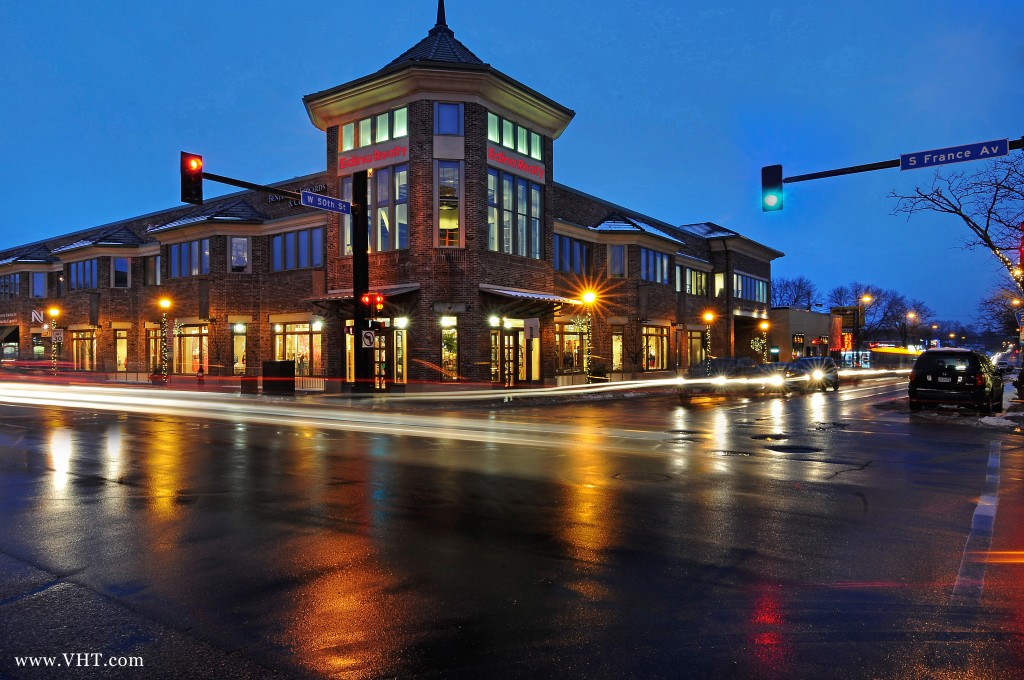
You should have at least one image larger than 250×250 but less than 1024×1024 and under 1MB. This square image should be your logo or a picture of your place of business. Each page allows you to upload 10 images. By default, if you upload one image or less, the page will display a map of your location along the photo strip a Google+.

You may currently have a web vendor promising you maximum SEO benefits. That they will get certain landing pages to show up high on search engine results pages, that certain key phrases will guarantee lead generation or you may even be promised a silver bullet solution for SEO. But do you really know if your site and your virtual tours are really getting the most exposure they can in the Real Estate Industry?
The online market for real estate is a completely different beast compared to any other industry. Could it be the fact that everyone is in the same field, looking for the same clients/consumers, who are searching for the same keywords? Or is it the fact that real estate is the single largest visual competition in the online world. A brokerage’ website success simply comes down to how visually appealing, literally and figuratively, it is to consumers, and thus to the search engines. That appearance extends through all of the marketing tools that brokerages use and none have greater effect on on the visual extension of your brand than that of virtual tours. But if what your virtual tour provider is promising you in terms of SEO sounds too good to be true, it probably is. Below, VHT debunks common myths that you may have heard from your Virtual Tour Providers. Have you been told... 1. “Video Syndication is a Backlinking Goldmine”Issue - Many video sites automatically set a nofollow attribute on any external links within their video pages. What this means is that search engines do not transfer PageRank or the SEO link markers from the video to the receiving website. They simply do not follow the link to the website.
Truth - Linkbuilding is now, more than ever, one of the single most important factors to your SEO success. The only difference is you need to be getting a variety of high authoritative sites pointing inbound links to your site. The numbers of links is not as important as where they are coming from. If your virtual tour provider or web vendor promises you backlinks, make sure you take the time to investigate where these links are coming from. If they are telling you YouTube is the silver bullet…Look elsewhere my friends. Be sure to have your virtual tour providers explain their link profile and how they can help build on yours.
2. “Your Virtual Tour is SEO optimized”This is often a myth for several very big reasons.
- Hosting a Virtual Tour on your Subdomain creates a duplicate page on your site
Issue -Duplicate content is a major SEO no-no. Most virtual tours are created using mere copies of the content that a brokerage has on their property details page. This is not actually original content, and it may even be flagged as duplicate content by search engine algorithms and, ultimately, have a negative effect on your site.
Truth - By hosting duplicate content on a subdomain, virtual tour companies are just creating a bigger mess than they probably bargained for and can actually cause penalties for the brokerage site.
- You are, in essence, creating a competitive arena from your own visual content
Issue - The virtual tour provider is essentially creating a competitive environment between your main property pages, your agent property pages (if you have them) and their tours, hosted on your domain. This can have a major affect on the page authority of your properties, because you are splitting them between several versions of the same content.
The more pages you have, the more spread out your link web is, thus having people linking to multiple versions of your property pages squanders the authority a canonical version of your property information should have.
Truth - Canonical links give authority to one version of a page, but passes on the link value and the content value of the aforementioned duplicate page. A virtual tour should be used as an extension of your property pages, not take away the authority the original pages should have. By Setting a canonical suggestive (Rel=”canonical” on your Virtual tour pages), the authority passes through from wherever you syndicate out to. Setting a preferred version of this content will help avoid duplicate content issues and pass the SEO benefit back to the brokerage site, where it should be.
- Virtual Tour Companies often sacrifice SEO value by hiding the valuable content behind Flash and Ajax
Issue - To this day, search engines do not crawl Ajax or Flash; therefore any content within/hidden behind those implementations are not crawled by search engines. The broker reaps none of the SEO benefit that a virtual tour can provide if that virtual tour is primarily made from Flash.
Truth – If your virtual tours are being created with Flash and Ajax your on-page information is not even seen. Likely, search engine crawlers are not even finding your tour and that means you are missing out on valuable leads or referrals from these page extensions. Many Virtual Tour companies have no idea the affect that certain programming languages can have on how search engines see their content. You need to really make the provider knows what they are talking about!
- Rich media is not optimized well for search engines, namely photos and videos.
Issue – Plain and simple, in most cases your visual assets are not being optimized for SEO. Many virtual tour providers and web vendors miss the boat on optimizing your rich media and fail to get this valuable content noticed. There seems to be a lack of focus on optimizing your visual assets, in a world where visual assets are your key marketing tool.
Truth- Educate yourself and ask your virtual tour provider to educate you about the rich media and html language that will make your content SEO friendly. Many rich media elements influence your search engine results position including the image name, alt attributes and image size. Best practice of image optimization is surprisingly positively correlated with good rankings. It also helps considerably with image search, a popular and oft-employed vertical/universal search system.
- “Virtual Tours will provide substantial increases in lead generation via Search engines.”
Issue - If the page is not SEO Optimized then it most likely is not found or even indexed on the search engines. If this is the case, that virtual tour provider is just blowing smoke, because leads cannot come from search engines if the search engines will not even index the tours.
Truth - Don’t miss out on the low hanging fruit because customers cannot find your tour or there is no mechanism that drives traffic. Work internally to create an online lead team that all information is funneled through or more importantly, Make sure there are clear calls to action on your virtual tour that get traffic back to your brokerage website. And, of course, make sure the tours themselves are being optimized.
The biggest Myth of all is that virtual tours are a silver bullet solution for your website’s SEO. Virtual tours should be a websites way of extending their reach to various avenues, to help generate traffic back to their site. To get a response you must capture a consumer’s attention with visuals, but if you’re not optimizing your virtual tours and visuals for SEO, if your web vendor is getting credit and seen as the authority of your content, then you’re losing the battle, and eventually the War. Having an aesthetically pleasing virtual tour doesn’t get you anywhere if you can’t be seen by consumers or by search engines. Real estate is all about being seen. Don’t let your virtual tour provider ruin that because of false promises about how SEO friendly their solution is. Location matters, but few real estate sites provide quality content to prospective buyers at the community level. If your website only provides information on listings, you’re missing out on a huge opportunity for user engagement and a stage to demonstrate your agents’ local expertise.
As the internet has become a primary source for buyers, (90% of buyers start their search online) it is crucial to make the best first impression. This means getting noticed in a pool filled with major SEO and SEM budgets geared toward driving traffic to real estate destination sites. It’s not an easy task.
Furthermore, nearly 70% of buyers who take action on a real estate site began their search with a local geography term. For example, ‘Old Downtown Algonquin Homes for Sale’ or Real Estate in Old Downtown Algonquin, IL’. Having locally relevant content on communities, neighborhoods and even schools makes a huge difference in your potential to get in front of buyers and present them with relevant content once they are on your site. Not only do buyers notice, search engines like Google take note of this too when ranking you in their search results.
Stand out in a Crowd – Community Profile Pages
How is one noticed in a sea of local information? Create localized content pages that you can utilize as landing pages for consumers, but put your own perspective on them. There are numerous sites out there devoted to providing community based information, but they all have their own unique perspective, or at least they should. A government site is different from Wikipedia, which is different from a Food Critic’s blog, which is then again different from the local school information page. Just providing the content to get another page on your does not get you noticed.
A brokerage’s local profile content must be tailored to a real estate perspective. People like to think of real estate professionals as authorities in their communities, therefore it is important to utilize that knowledge base. The way a real estate professional sees a community is very different than that of a government official or even the consumer. Interested buyers and potential clients are looking for different information than generic Wikipedia data and U.S. Census statistics.
How can you start beefing up your neighborhood pages?
Get specific. Get beyond specific. Narrow down what keywords you’d like to be found for in a search that’s local to you and incorporate those keywords into your content on these pages. The easiest way to do this is to optimize your content as a neighborhood expert. This means that in addition to the listings and photos on your website, you should also have these unique pages that portray the added value of the surrounding neighborhood where your listings are located. Here are some ways to incorporate that info:
Location matters, but few real estate sites provide quality content to prospective buyers at the community level. If your website only provides information on listings, you’re missing out on a huge opportunity for user engagement and a stage to demonstrate your agents’ local expertise.
As the internet has become a primary source for buyers, (90% of buyers start their search online) it is crucial to make the best first impression. This means getting noticed in a pool filled with major SEO and SEM budgets geared toward driving traffic to real estate destination sites. It’s not an easy task.
Furthermore, nearly 70% of buyers who take action on a real estate site began their search with a local geography term. For example, ‘Old Downtown Algonquin Homes for Sale’ or Real Estate in Old Downtown Algonquin, IL’. Having locally relevant content on communities, neighborhoods and even schools makes a huge difference in your potential to get in front of buyers and present them with relevant content once they are on your site. Not only do buyers notice, search engines like Google take note of this too when ranking you in their search results.
Stand out in a Crowd – Community Profile Pages
How is one noticed in a sea of local information? Create localized content pages that you can utilize as landing pages for consumers, but put your own perspective on them. There are numerous sites out there devoted to providing community based information, but they all have their own unique perspective, or at least they should. A government site is different from Wikipedia, which is different from a Food Critic’s blog, which is then again different from the local school information page. Just providing the content to get another page on your does not get you noticed.
A brokerage’s local profile content must be tailored to a real estate perspective. People like to think of real estate professionals as authorities in their communities, therefore it is important to utilize that knowledge base. The way a real estate professional sees a community is very different than that of a government official or even the consumer. Interested buyers and potential clients are looking for different information than generic Wikipedia data and U.S. Census statistics.
How can you start beefing up your neighborhood pages?
Get specific. Get beyond specific. Narrow down what keywords you’d like to be found for in a search that’s local to you and incorporate those keywords into your content on these pages. The easiest way to do this is to optimize your content as a neighborhood expert. This means that in addition to the listings and photos on your website, you should also have these unique pages that portray the added value of the surrounding neighborhood where your listings are located. Here are some ways to incorporate that info:
- Articles with important information about the neighborhood, utility information, and great places to eat, etc
- Photos of local hot spots and interesting neighborhood events you’ve attended
- Photo/video/blog posts from your agents of dishes from restaurants, cool buildings or landmarks in the area
- Articles about upcoming events and festivals in the neighborhood or general neighborhood news
- Video interviews with local community experts
- Video tour of a hot property that has come up for sale
- Neighborhood video tours
- Home values, selling prices and other market information.
- Updated images, photos, and listings
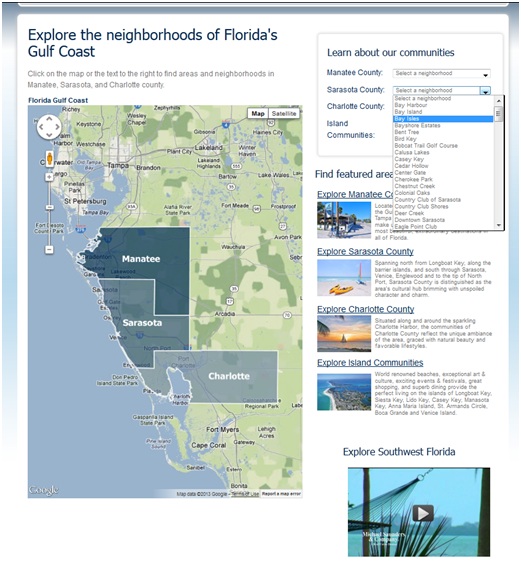 After selecting a specific community page, in this case Bay Isles, Florida, we can see unique written content, maps, rich media (video, photos) and textual content, business reviews, video tours, blog posts targeted at the Bay Isles area, and of course, recommended Bay Isles listings. All this dynamic content creates user engagement.
After selecting a specific community page, in this case Bay Isles, Florida, we can see unique written content, maps, rich media (video, photos) and textual content, business reviews, video tours, blog posts targeted at the Bay Isles area, and of course, recommended Bay Isles listings. All this dynamic content creates user engagement.
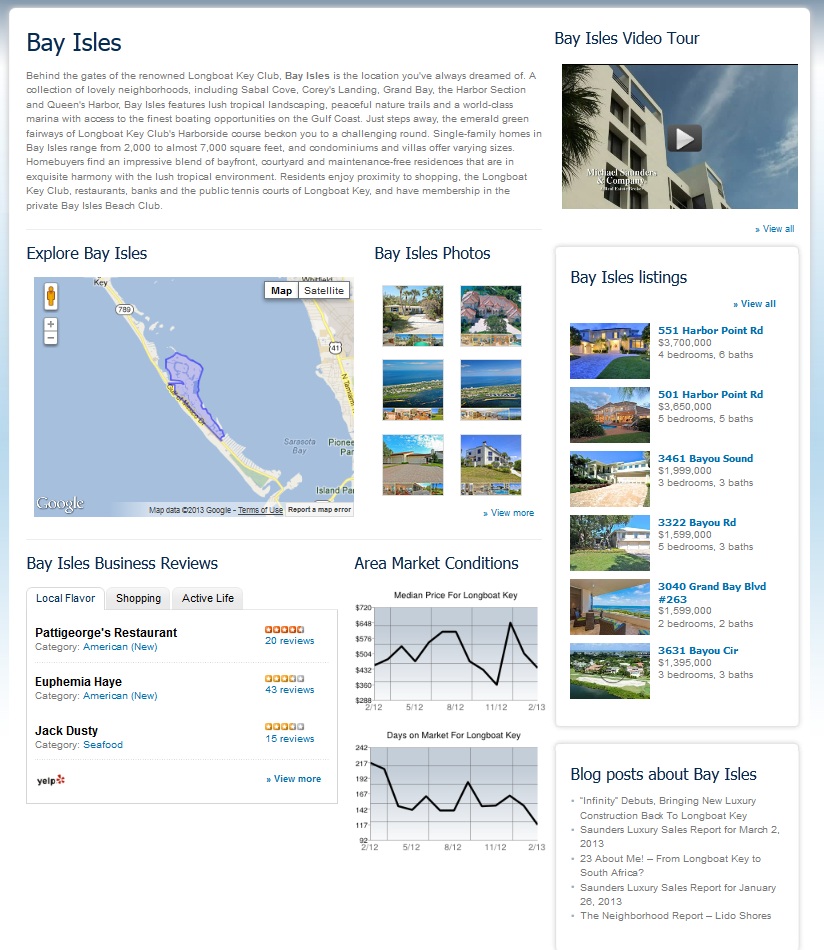 This is especially powerful for attracting relocation buyers who are not as familiar with various cities and neighborhoods in your community. Help them understand why people in your community live where they live, what it looks like, and that your agents have expertise in the communities that interest them. This increases conversions to leads, and should also increase conversions from leads to transactions.
Local-search visibility should be a springboard – a launching pad. Local SEO is most valuable when you use it to open up even more streams of potential customers. With dedicated time and resources, you can turn your stale website into a hub of targeted community content. Your website will no longer be your typical home buyer/ seller resource with canned information. It is a rich center of information for any potential client. It has a web page on each community in your territory, each one touting a compilation of information that only your website can provide. Now that's a web page worthy of a number one spot.
This is especially powerful for attracting relocation buyers who are not as familiar with various cities and neighborhoods in your community. Help them understand why people in your community live where they live, what it looks like, and that your agents have expertise in the communities that interest them. This increases conversions to leads, and should also increase conversions from leads to transactions.
Local-search visibility should be a springboard – a launching pad. Local SEO is most valuable when you use it to open up even more streams of potential customers. With dedicated time and resources, you can turn your stale website into a hub of targeted community content. Your website will no longer be your typical home buyer/ seller resource with canned information. It is a rich center of information for any potential client. It has a web page on each community in your territory, each one touting a compilation of information that only your website can provide. Now that's a web page worthy of a number one spot.

 When shopping for real estate, consumers have come to expect flawless, professional photography as a given. Ninety percent of buyers are online, and they’re focusing on photographs as they browse listing after listing. If the photos don’t wow them, they just move on to the next property.
When shopping for real estate, consumers have come to expect flawless, professional photography as a given. Ninety percent of buyers are online, and they’re focusing on photographs as they browse listing after listing. If the photos don’t wow them, they just move on to the next property.
Photos by VHT Studios.
 The simple answer to the question “Does keyword ranking even matter anymore?” is yeah, it still does. Frankly, I sort of get tired of this question, and the response “keywords don’t matter anymore, Post Penguin and Panda.” Think of it this way, if you are a real estate brokerage, and you focus your content and the keywords on your site, around how awesome of a community you have, but never include real estate focused key phrases, you’re not going to be seen as relevant for real estate related consumer queries. If I fail to use the phrase “homes for sale” on my site, I’m not going to show up for searches that include that phrase. It’s somewhat of a simple concept.
So, let’s cut right to the chase. Don’t forget about your keyword focus when building content, otherwise you might as well count yourself out, in search engine placements. And then all the time you spent creating killer content is, well, irrelevant. Build relevancy for your content, don’t just build “unique” content. What better way to do that than have a topic of focus (your keywords). Showing up for relevant queries in the search results is the first hurdle you’ll have to face, and it will probably be a tough one. If you are looking for somewhere to start in improving your SERP (search engine results position), start with your keywords (or think of it as, start with the spotlight of each page).
Google used to rely heavily on keywords. What do we mean by a keyword? A keyword is a word or phrase that search users type into a search bar when they are looking for your product or service. Google would use the terms found on your site, in your keyword Meta tag and in your Meta elements to establish what your site was about and how they should direct search traffic for related queries. It was only a matter of time before crafty developers and SEO consultants stuffed it full of keywords that were not necessarily relevant to their website content, so Google made the decision to ignore it in determining search engine rankings.
Okay, so if these items are no longer a ranking factor why should you spend time writing Meta tags and Meta descriptions for each page and include keywords? A keyword is a word or phrase that search users type into a search bar when they are looking for your product or service. Google would use the terms found on your site, in your keyword Meta tag and in your Meta elements to establish what your site was about and how they should direct search traffic for related queries.
First things first, conduct keyword research that establishes what consumers are actually typing into the search engines to find your site’s subject matter. Then it’s your job to implement those keywords into your page content and major elements naturally/organically. It is still important to first focus your attention on keywords, and not just “how cool can I make my content,” but ultimately you want to meld that creativity in with your keyword data.
The simple fact of the matter is while you may pick up tactics every now and then or work with certain SEO strategies as Google changes their algorithms and rules, over time every fad will pass and just two key elements will remain.
You will ALWAYS want to know what people are searching for…
You will ALWAYS want to create content that people enjoy/find useful…
Luckily both of these key aspects of SEO can be accomplished by starting of with keyword research. Focus on certain key phrases helps meld your site’s content and keywords help give relevancy to the content being created.
With that, we move to using your keywords to create relevant content.
If you always focus on creating content that is targeted to the right keywords for your audience, then you will always have a solid base to work from and you can worry as much or as little as you want about adding the latest search optimization technique or link building campaigns.
It’s often said that content is king, but the truth is “creating content that people are searching for is king”. It may not sound as catchy but it’s the one truth in SEO that will never change. Focus on your keywords and content and the rest will follow.
The simple answer to the question “Does keyword ranking even matter anymore?” is yeah, it still does. Frankly, I sort of get tired of this question, and the response “keywords don’t matter anymore, Post Penguin and Panda.” Think of it this way, if you are a real estate brokerage, and you focus your content and the keywords on your site, around how awesome of a community you have, but never include real estate focused key phrases, you’re not going to be seen as relevant for real estate related consumer queries. If I fail to use the phrase “homes for sale” on my site, I’m not going to show up for searches that include that phrase. It’s somewhat of a simple concept.
So, let’s cut right to the chase. Don’t forget about your keyword focus when building content, otherwise you might as well count yourself out, in search engine placements. And then all the time you spent creating killer content is, well, irrelevant. Build relevancy for your content, don’t just build “unique” content. What better way to do that than have a topic of focus (your keywords). Showing up for relevant queries in the search results is the first hurdle you’ll have to face, and it will probably be a tough one. If you are looking for somewhere to start in improving your SERP (search engine results position), start with your keywords (or think of it as, start with the spotlight of each page).
Google used to rely heavily on keywords. What do we mean by a keyword? A keyword is a word or phrase that search users type into a search bar when they are looking for your product or service. Google would use the terms found on your site, in your keyword Meta tag and in your Meta elements to establish what your site was about and how they should direct search traffic for related queries. It was only a matter of time before crafty developers and SEO consultants stuffed it full of keywords that were not necessarily relevant to their website content, so Google made the decision to ignore it in determining search engine rankings.
Okay, so if these items are no longer a ranking factor why should you spend time writing Meta tags and Meta descriptions for each page and include keywords? A keyword is a word or phrase that search users type into a search bar when they are looking for your product or service. Google would use the terms found on your site, in your keyword Meta tag and in your Meta elements to establish what your site was about and how they should direct search traffic for related queries.
First things first, conduct keyword research that establishes what consumers are actually typing into the search engines to find your site’s subject matter. Then it’s your job to implement those keywords into your page content and major elements naturally/organically. It is still important to first focus your attention on keywords, and not just “how cool can I make my content,” but ultimately you want to meld that creativity in with your keyword data.
The simple fact of the matter is while you may pick up tactics every now and then or work with certain SEO strategies as Google changes their algorithms and rules, over time every fad will pass and just two key elements will remain.
You will ALWAYS want to know what people are searching for…
You will ALWAYS want to create content that people enjoy/find useful…
Luckily both of these key aspects of SEO can be accomplished by starting of with keyword research. Focus on certain key phrases helps meld your site’s content and keywords help give relevancy to the content being created.
With that, we move to using your keywords to create relevant content.
If you always focus on creating content that is targeted to the right keywords for your audience, then you will always have a solid base to work from and you can worry as much or as little as you want about adding the latest search optimization technique or link building campaigns.
It’s often said that content is king, but the truth is “creating content that people are searching for is king”. It may not sound as catchy but it’s the one truth in SEO that will never change. Focus on your keywords and content and the rest will follow. 
 VHT has created this essential guide to ensuring that your brokerage has the most stunning and striking images in your market and is visibly seen as far superior to your competitors. We’ve divided the guide into four main categories: 1) getting great photographs, 2) displaying great photographs, 3) managing your visual assets, 4) getting the most out of your visual assets.
Click here for the full paper.
VHT has created this essential guide to ensuring that your brokerage has the most stunning and striking images in your market and is visibly seen as far superior to your competitors. We’ve divided the guide into four main categories: 1) getting great photographs, 2) displaying great photographs, 3) managing your visual assets, 4) getting the most out of your visual assets.
Click here for the full paper.
It’s quick and easy to post a photo of a home you’re selling, plus, according to studies, it’s the best way for your small business to engage with fans (Source: Pagemodo).
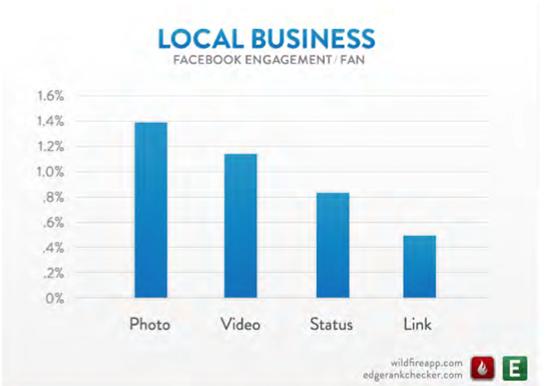

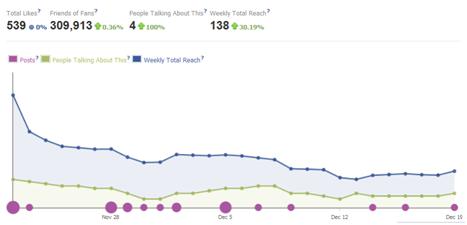
 This is an excellent tool to utilize. It can tell you the age range of those viewing and interacting with your page as well as their gender, location, your most popular posts and the reach of each post on your page. This information can provide a great deal of insight into exactly who your customers are so you can tailor your page to these specific individuals and create the most engagement.
There is a lot to learn in Facebook Insights, take some time to play around with it, and read up here.
This is an excellent tool to utilize. It can tell you the age range of those viewing and interacting with your page as well as their gender, location, your most popular posts and the reach of each post on your page. This information can provide a great deal of insight into exactly who your customers are so you can tailor your page to these specific individuals and create the most engagement.
There is a lot to learn in Facebook Insights, take some time to play around with it, and read up here.
Social media has definitely become the wave of the future for real estate marketing. And being good with social media is one thing, but learning to be savvy, smart and differentiated is another. Below are the first 5 of 10 Facebook guidelines for real estate agents and brokers.
 1. Promote Your Content
Facebook is no longer a chronological river of posts -- you can opt to draw more attention to a single post by "highlighting" it. Highlight your hot new listing or latest sold property by selecting the star icon on the top right corner of any post on your Timeline. Doing so displays your update across the width of your page, giving more weight to key news.
Also take advantage of the "Pin to Top" option on your Brand Timeline. Start with one post per week to extend the life of important content. When you pin something onto the timeline, it not only becomes larger but it also becomes the first item within the Timeline itself.
2. Have good photos and detailed captions
People love good visuals. If the photos posted on a realtor’s Facebook Page are not appealing, they house they’re selling probably won’t be, either. What’s more, instead of simply posting photos of a home, use the caption portion of a photo to sell the home.
Is the home great for a family looking for a place near an elementary school? Are the carpets new? Is there a big, fenced-in yard for pets to run around in? The more information and specific details about a home the realtor can provide a prospective buyer, the better. This will save a real estate agent time, effort and energy as the genuinely interested buyers pop up after seeing your property online.
3. Brand your homes and recognize a target client
Take advantage of the ‘About Me’ portion of your Business’s Facebook Page. Rather than keeping it bare bones, realtors need to use the section to be honest, describe their niche homes and what homes are most appealing to them to sell.
Is working with families to help them find the perfect family home appealing? Are homes that need a little love charming? Are modest to luxury condos and apartments an area of expertise? If a potential buyer reads that your style of home matches or is similar to theirs that they’re looking for, the selling pitch becomes that much easier on an agent.
Moreover, it’s difficult to sell and appeal to a broad audience in a largely varied market. Therefore, the most effective approach to any marketing strategy is to find a target.
1. Promote Your Content
Facebook is no longer a chronological river of posts -- you can opt to draw more attention to a single post by "highlighting" it. Highlight your hot new listing or latest sold property by selecting the star icon on the top right corner of any post on your Timeline. Doing so displays your update across the width of your page, giving more weight to key news.
Also take advantage of the "Pin to Top" option on your Brand Timeline. Start with one post per week to extend the life of important content. When you pin something onto the timeline, it not only becomes larger but it also becomes the first item within the Timeline itself.
2. Have good photos and detailed captions
People love good visuals. If the photos posted on a realtor’s Facebook Page are not appealing, they house they’re selling probably won’t be, either. What’s more, instead of simply posting photos of a home, use the caption portion of a photo to sell the home.
Is the home great for a family looking for a place near an elementary school? Are the carpets new? Is there a big, fenced-in yard for pets to run around in? The more information and specific details about a home the realtor can provide a prospective buyer, the better. This will save a real estate agent time, effort and energy as the genuinely interested buyers pop up after seeing your property online.
3. Brand your homes and recognize a target client
Take advantage of the ‘About Me’ portion of your Business’s Facebook Page. Rather than keeping it bare bones, realtors need to use the section to be honest, describe their niche homes and what homes are most appealing to them to sell.
Is working with families to help them find the perfect family home appealing? Are homes that need a little love charming? Are modest to luxury condos and apartments an area of expertise? If a potential buyer reads that your style of home matches or is similar to theirs that they’re looking for, the selling pitch becomes that much easier on an agent.
Moreover, it’s difficult to sell and appeal to a broad audience in a largely varied market. Therefore, the most effective approach to any marketing strategy is to find a target.
 4. Do Ask Questions and Involve Your Fans
Want your fans to express their views on a topic? Ask them. Want your fans to share their favorite content with you? Ask them. Want your fans to share your content? Ask them. Want to… You get the point.
4. Do Ask Questions and Involve Your Fans
Want your fans to express their views on a topic? Ask them. Want your fans to share their favorite content with you? Ask them. Want your fans to share your content? Ask them. Want to… You get the point.


